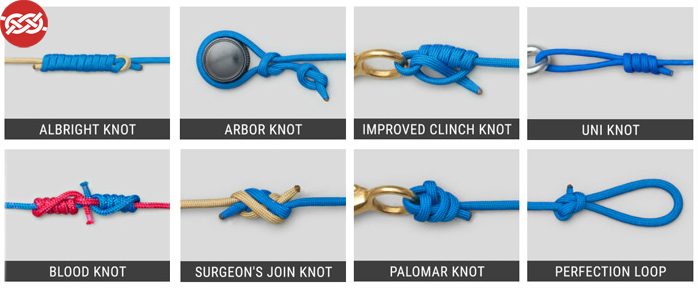8 Fishing Knots You Absolutely Must Know Part 1
Every fisherman knows that tying a fishing knot is one of the most essential skills to know. After all, your ability to tie the proper knot correctly will ultimately determine how successful you are. We have assembled some of the best fishing knots that every angler needs to know. From the Albright to the Perfection Loop join us as we explore these vital links between you and the fish.
The first fishing knots we’ll explore in part 1 of this 2 part series are the Albright, Arbor, Blood, and Surgeon’s Join knot. These knots are used for joining lines together or attaching lines to spools. Lets dive in and learn how to tie some fishing knots.
Albright Knot
The Albright Knot is a very reliable knot for joining lines of unequal diameters or different materials. For example, if you want to join braided to monofilament line then this is your knot. One of the most common uses is to join fly line to the backing line. This versital knot can be used anytime that you want to join two lines together. This is a must have in your tool box and the reason it is a top slot on our list. Watch the video below to see how this knot is tied or visit Animated Knots for a step by step guide.
Arbor Knot
The Arbor knot is used for attaching line to your reel. It can be used for spinning reels and baitcast. This knot is not designed to keep a fish from pulling the line off the reel in the event of it getting spooled. Instead it’s sturdy enough to hold if for some reason you needed to retrieve your rod by its line. This is a very fast knot to tie that doesn’t slip when winding the fishing line onto the spool. Consider using if you you have fluorocarbon or monofilament lines. If you are using braided superlines or unifilaments then you need a spool that is non-slip braid ready. No need to worry about this knot loosening under tension since it is designed to tighten when pulled. Check out the video below or visit Animated Knots for a walk through.
Blood Knot
The blood knot is similar to the Albright in that it is for joining two lines together. The difference is that the blood knot is for joining two lines that are the same diameter. It can be used if your line breaks for joining sections of leader or tippet, and is one of the best fishing knots for this purpose. This creates a very clean knot and works best with monofilament line where the lines are no more than .002″ diameter difference. Again we have a video for you to watch or you can check out the Animated Knots to learn more.
Surgeon’s Join Knot
Lastly we have the surgeon’s knot which is used when you need to join lines that are moderately unequal in diameter. Used by many fly fishers to attach the leader to a tippet that suits your fly. This common fishing knot is used to join two monofilament lines. Being one of the easiest knots to tie, it’s a great option when you find yourself in less that ideal conditions or you need it done quickly. This knot is tightened by pulling on all four stands to seat the knot. Check out more of the surgeon knot on Animated Knots.
So there you have it, four extremely useful fishing knots that every angler needs to know. Part 2 of our series will show how to attach line to lures and fly’s. What are your go to fishing knots for joining lines? Let us know in the comments what would make your top 4.
I grew up in Canada, but unfortunately, I did not take advantage of shooting or hunting when I lived there. I just didn’t grow up with it, but I did fish a lot. It’s only after I joined a firearm company that I could reap the benefits of having great mentors teach me the ropes. Now I’m hooked and want to experience everything I can! So much so, I was compelled to co-found this site. I hope you enjoy it, and all feedback is welcome.





